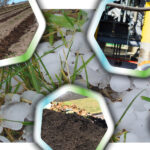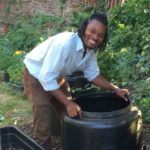 ‘
‘
Nora Goldstein
BioCycle February 2015
We are working with colleagues at several regional U.S. EPA offices on the agenda for BioCycle’s April 13 Preconference Workshop, “Food For People, Food For Soil.” The workshop is part of BioCycle’s 29th Annual West Coast Conference, April 13-16, 2015, in Portland, Oregon (see pages 15-18 in this issue for final agenda). The original idea for the workshop title came from speaking at the Last Food Mile Conference, held recently in Philadelphia, and organized by the University of Pennsylvania School of Veterinary Medicine. The conference focused on how to reduce food wastage “post harvest” and along the food supply chain. The Last Food Mile also addressed the challenges of feeding the expected 9 billion people on the planet by 2050, and the reality that about 50 million Americans live in food-insecure households.
At a dinner for presenters, Dr. Zhengxia Dou of the University of Pennsylvania and host of the event, asked the speakers to briefly introduce themselves and describe their involvement in the fields of food wastage and sustainable food production. As each person spoke, it became clear that I was one of the few speakers not working directly in those fields — although BioCycle reports regularly in the magazine and at our conferences on strategies to reduce wasted food. In thinking about how to succinctly state our connections to this conversation, it hit me when BioCycle enters the picture: It’s when food, no longer edible, needs to be managed sustainably. And more specifically, our connection is both how to manage the inedible food (collect and process), and make sure that the compost and/or digestate produced by that management process becomes an amendment to build healthy soils to grow more food. So when my turn came, I observed while most of you focus on Food For People, BioCycle — in large part — focuses on Food For Soil.
The phrase stuck, and thus “Food For People, Food For Soil” became the title of our April 13 Preconference Workshop, which will highlight solutions that connect the dots between wasted food, hunger and nutrition, drought and soil health (via organics recycling) and local food production. An overarching theme is how to close the loop in communities to have the greatest impact. We are working with EPA colleagues because food recovery has become a significant program initiative for the agency, e.g., the Food Recovery Challenge, the Food: Too Good To Waste Toolkit for households, and the recently released Reducing Wasted Food and Packaging Toolkit targeted at the foodservice sector. These initiatives are excellent platforms for connecting the conversations (aka, breaking down silos) between food rescue and donation organizations, solid waste and social service agencies, farmers, composters, community gardeners and others.
In the midst of our workshop and conference planning, we received a copy of an article written by the Environmental Defense Fund (EDF). The article focuses on the environmental impacts caused by excessive use of farm fertilizers, emphasizing water quality and greenhouse gas emissions. EDF offers four reasons why this “seemingly intractable problem may soon become a thing of the past.” They include crop-based carbon standards to use fertilizers more efficiently, demand for sustainably grown grains, new technologies to optimize fertilizer use and incentives to reduce fertilizer costs. The article does not discuss how use of soil amendments such as compost and mulch can reduce fertilizer and water requirements, help suppress certain plant diseases, sequester carbon and overall, build healthier soils.
We are going to reach out to EDF and connect our conversations. Soils improved with compost and digestate are critical to healthy, functioning ecosystems. And typically that compost and digestate are produced locally from renewable resources — including the inedible portion of the wasted food.









